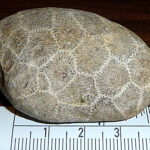Easily distracted by rocks

On the window sill in my office there is an ever growing collection of rocks. Most of them I've found around the grounds of Christensen's, some more exotic ones arrived in tree balls or were given to me by customers. Rocks have interested me since I was a kid. I had 'em stashed everywhere - dirty rocks in my sock drawer, jars and buckets full of rocks all over the yard, and a couple cool polished specimens were displayed on my dresser.
As I got older I wanted to know the stories behind the rocks, what they are made of, and how they came to be where I found them.

Michigan is a fantastic place for a rock-lover to reside due to an amalgamation of geological events.
400 million years ago this area was a briny tropical sea just north of the equator. As the landmass drifted northward jungles full of displaced plants and animals left behind rich soils and minerals, whilst retreating seas precipitated vast deposits of salt and sand. The ancient sea life produced fossils like Petoskey Stones and Crinoids in abundance that we find on our beaches today.

Michigan has something else going for it when it comes to cool rocks. Volcanos!! During the mid-continental rift fiery lava gurgled up great amounts of minerals from the molten belly of our planet. When liquid magma solidifies underground it becomes igneous rocks like granite and obsidian. Granite countertops are made of magma that has slowly cooled under pressure, allowing time for crystallization. A lot of the granite you'll find in Michigan has red in it. The red color comes from the iron oxide that’s mixed in with the feldspar and quartz. When lava cools above ground it hardens into extrusive types of igneous rocks like basalt and pumice. One of my favorite rocks is called pudding stone. It's a colorful conglomerate of red jasper, quartz, and other pebbles that have been metamorphosed into quartzite.

North America was once home to towering ice sheets over a mile thick. The Earth's crust was actually deformed under the weight of these ice age giants. As they slowly scraped their way down the continent countless tons of material were picked up along way (including my pudding stones). The massive ice sheets eventually settled in our Great Lakes Basin and melted, releasing rocks and debris that span both geography and time.


I found this fossilized coral in my own back yard. And check out this Yooperlite - it fluoresces under UV! (What is "Yooperlite"?)

The combination of glacial transportation, continental drift, and volcanic upheaval have led to perhaps the most splendid mixes of rocks of anywhere in the world.
